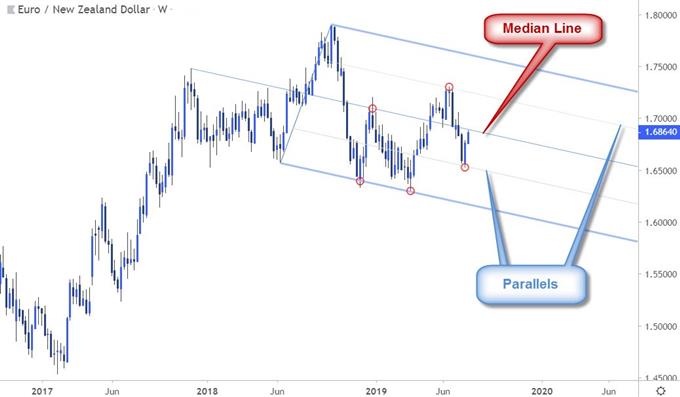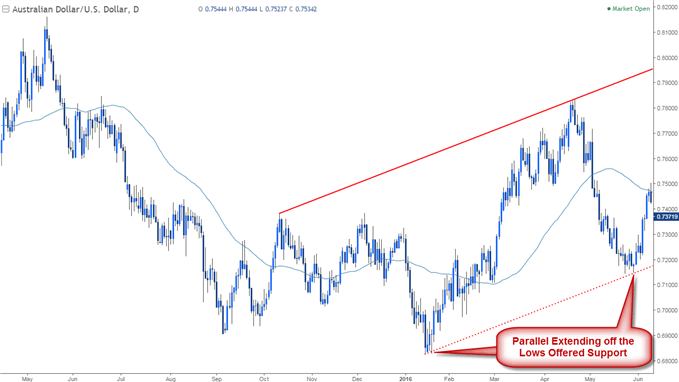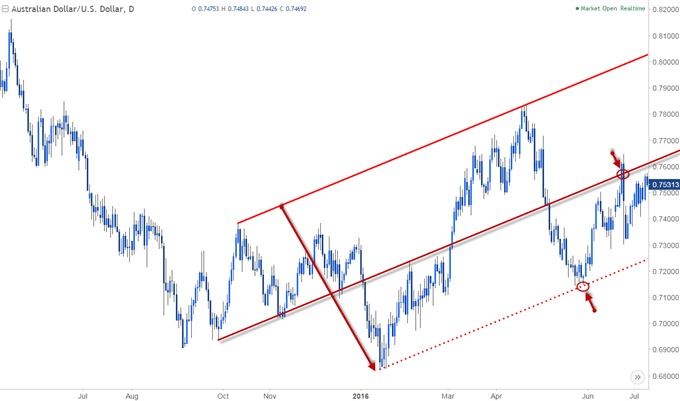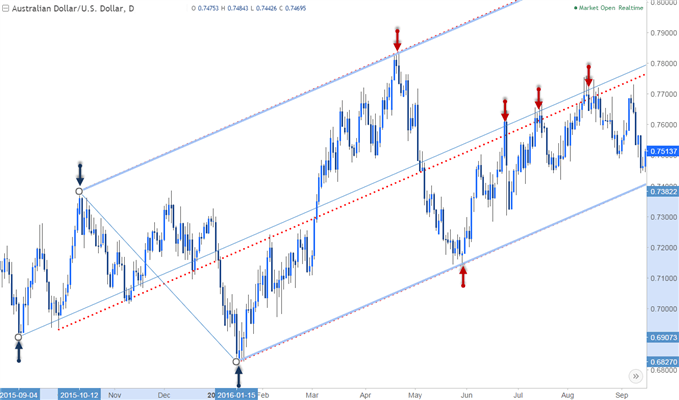This piece focuses pitchfork analysis and median line trading, and reviews how parallels of these trendlines can be utilized to give structure to a market advance or decline. The objective of this methodology is to attempt to identify the gradient or slope of the market trend in order to zero-in on possible levels of support and resistance.
We’ll start by exploring pitchforks and median lines in more detail followed by a deconstruction of a setup. This will illustrate how we formulate a given trade opportunity using pitchfork analysis and median lines.
This article on trading with pitchforks and median-lines is the second in a series exploring pitchforks and slopes:
What is Andrew’s Pitchfork?
Pitchforks were developed by Dr Alan Andrews as a basic trend tool that identifies price channels and gives structure to a market advance or decline. These trendlines offer reaction zones and offer a guidance in both price and time.
EUR/NZD chart showing a pitchfork

New in forex trading? We are professional software developers for the forex market. Check out our expert advisors. Many traders trust their accounts to automated trading. If you are beginner at financial market, trade with help of our best forex robot developed by our programmers. You can try free trader robot and to test results in your Metatrader.
What is a Median-line?
A median line is simply the bisector of a given channel or range. The median-line of a pitchfork often offers a point of reference and may trigger inflections or pivots in price. If a price breaks above the median-line, the target shifts to the upper parallel – likewise if price breaks below the median-line, the target shifts to the lower parallel.
EUR/NZD chart showing a parallels within a pitchfork

Using Pitchforks and Median Lines
The base case scenario is that when prices comes off the lower parallel they will gravitate towards the median-line or bisector of the given range and vice versa off the upper parallel. With the same respect, once the median-line is broken as resistance it will serve as support for a rally into the upper parallel – and the opposite when the median-line is broken as support (median-line will offer resistance on a move into the lower parallel).
The simplest way to get started in pitchfork analysis and median line trading is to identify an initial trendline of support or resistance that the market has been responding to. Once that trendline has been found, a parallel (copy) of that trendline can then be extended to the other side of the move (most recent key high / low) to create a channel – this is the very basics of identifying slope.
The parallel should now serve as the support and resistance structure for the trend and as the market continues to advance, look for pivots off corresponding parallels of that slope for further validation that we have identified the proper gradient or angle of the trend.
AUD/USD Price Chart Showing a Trendline

Consider the trendline (resistance) connecting the two major peaks in late-2015 and early-2016 in AUD/USD. A parallel of this slope extending off the 2016 low was critical in identifying support on the late-April decline as Aussie was in free-fall.
AUD/USD Price Chart Showing a Parallel

This rudimentary use of parallels can be extremely useful in identifying basic pivots in price- which for us as traders, means entry / exit points. But where would we look for resistance on this reversal off support? Enter the pitchfork.
AUD/USD Price Chart Showing a Median-line

In the AUD/USD example above, the June rebound off the lower parallel calls for a rally into the median-line of the range. Indeed, a parallel bisecting the channel (extending off the 2015 September low) offered a clear pivot in early 2016 and was an effective target for the rally which capped out just higher later that month. This simple example illustrates how we use slope as a basis for targeting support / resistance.
AUD/USD Price Chart Showing a Pitchfork

Consider the same chart above. A pitchfork can be applied by using the three reference points of the most recent low-high-low into the 2016 open (blue arrows), offering an up-trend to work with. As often will be the case, the slope is IDENTICAL to the previous slope derived off the subsequent April high- meaning this formation would have alerted us much earlier to where the April rally ultimately found resistance.
Note that on each subsequent rally, the advance reversed off the median-line with the final attempt in August ultimately pulling back into the lower parallel. This simple drill is meant to highlight that identifying the proper gradient, more-so than the tool used, is the most important aspect of slope analysis- obviously the earlier the better.
NOTE: if you have no time to study all the tools of the trade and you have not funds for errors and losses – trade with the help of our best forex robot developed by our professionals. It is fully automated, you need install it in your Metatrader only. Write us to support@signal2forex.com and we’ll help you with installation and answer all questions.
How to Draw Pitchforks
Some important aspects to keep in mind when drawing pitchforks:
- In an up-trend: reference points should be a low-high-low
- In a down-trend: reference points should be high-low-high
- When price approaches the median line, they will:
- Reverse, or
- Price will trade through the median line and head for the upper / lower median line parallels
- Stress the Slope, not the reference points: When applying pitchforks, the most important thing is the slope that’s produced- Has price been responding to that slope? Have we seen pivots / reactions at the touch points? These are the factors that should be considering before operating off any given trendline. That said, there will be times you will need to adjust your reference points secondary lows/highs in order to fit the gradient more accurately.
- Once price has broken out of the formation- look to identify a new pitchfork in the opposite direction. If price breaks the lower parallel of an ascending slope- Look for a near-term high-low-high as reference points for the correction lower. If price breaks the upper parallel of a descending pitchfork – look for a low-high-low to offer the up-slope on the reversal.
Once you have clearly identified a slope, parallels extending off key highs and lows will often times offer clear pivots in price and will be levels of interest for both targets and entries. It’s also worth noting that median-lines will be of added technical significance when they converge on other key technical indicators such as moving averages, Fibonacci levels, monthly / yearly highs and lows and sentiment.
Key Takeaways on Pitchforks and Median Lines
Pitchforkscan be extremely useful in identifying key reaction levels within market trends and once mastered, can be a crucial part of your trading strategy. Always keep in mind that the primary focus is to give structure to the market and better locate points of interest for trade opportunities.
In part three of the series, our article on Multi Time Frame Analysisdiscusses combining pitchforks with various overlay indicators. This can help in identifying opportunities in both price and time to offer a more holistic trading approach.
Don’t forget to sign up for the Weekly Strategy Webinar to learn more about trading with pitchforks and media lines, and for more trading tips and strategies, download a Free Forex Trading Guide.
Read how to trade Forex profitably and what are trading robots…

 Signal2forex.com - Best Forex robots and signals
Signal2forex.com - Best Forex robots and signals




